» Site Map
» Home Page
Historical Info
» Find Friends - Search Old Service and Genealogy Records
» History
» QAIMNS for India
» QAIMNS First World War
» Territorial Force Nursing Service TFNS
» WW1 Soldiers Medical Records
» Field Ambulance No.4
» The Battle of Arras 1917
» The German Advance
» Warlencourt Casualty Clearing Station World War One
» NO 32 CCS Brandhoek - The Battle of Passchendaele
» Chain of Evacuation of Wounded Soldiers
» Allied Advance - Hundred Days Offensive
» Life After War
» Auxiliary Hospitals
» War Graves Nurses
» Book of Remembrance
» Example of Mentioned in Despatches Letter
» Love Stories
» Autograph Book World War One
» World War 1 Letters
» Service Scrapbooks
» QA World War Two
» Africa Second World War
» War Diaries of Sisters
» D Day Normandy Landings
» Belsen Concentration Camp
» Italian Sailor POW Camps India World War Two
» VE Day
» Voluntary Aid Detachment
» National Service
» Korean War
» Gulf War
» Op Telic
» Op Gritrock
» Royal Red Cross Decoration
» Colonels In Chief
» Chief Nursing Officer Army
» Director Army Nursing Services (DANS)
» Colonel Commandant
» Matrons In Chief (QAIMNS)
Follow us on Twitter:

» Grey and Scarlet Corps March
» Order of Precedence
» Motto
» QA Memorial National Arboretum
» NMA Heroes Square Paving Stone
» NMA Nursing Memorial
» Memorial Window
» Stained Glass Window
» Army Medical Services Monument
» Recruitment Posters
» QA Association
» Standard
» QA and AMS Prayer and Hymn
» Books
» Museums
Former Army Hospitals
UK
» Army Chest Unit
» Cowglen Glasgow
» CMH Aldershot
» Colchester
» Craiglockhart
» DKMH Catterick
» Duke of Connaught Unit Northern Ireland
» Endell Street
» First Eastern General Hospital Trinity College Cambridge
» Ghosts
» Hospital Ghosts
» Haslar
» King George Military Hospital Stamford Street London
» QA Centre
» QAMH Millbank
» QEMH Woolwich
» Medical Reception Station Brunei and MRS Kuching Borneo Malaysia
» Military Maternity Hospital Woolwich
» Musgrave Park Belfast
» Netley
» Royal Chelsea Hospital
» Royal Herbert
» Royal Brighton Pavilion Indian Hospital
» School of Physiotherapy
» Station Hospital Ranikhet
» Station Hospital Suez
» Tidworth
» Ghost Hunt at Tidworth Garrison Barracks
» Wheatley
France
» Ambulance Trains
» Hospital Barges
» Ambulance Flotilla
» Hospital Ships
Germany
» Berlin
» Hamburg
» Hannover
» Hostert
» Iserlohn
» Munster
» Rinteln
» Wuppertal
Cyprus
» TPMH RAF Akrotiri
» Dhekelia
» Nicosia
Egypt
» Alexandria
China
» Shanghai
Hong Kong
» Bowen Road
» Mount Kellett
» Wylie Road Kings Park
Malaya
» Kamunting
» Kinrara
» Kluang
» Penang
» Singapore
» Tanglin
» Terendak
Overseas Old British Military Hospitals
» Belize
» Falklands
» Gibraltar
» Kaduna
» Klagenfurt
» BMH Malta
» Nairobi
» Nepal
Middle East
» Benghazi
» Tripoli
Field Hospitals
» Camp Bastion Field Hospital and Medical Treatment Facility MTF Helmand Territory Southern Afghanistan
» TA Field Hospitals and Field Ambulances
28th Combined General Hospital Mosul and Kirkuk World War Two
Part 11 of the War Diary of QAIMNS Lieutenant Colonel Hughes where she travels to the British Army HQ in Baghdad and receives orders to open up a large hospital in caves in Mosul which then moves to tents in Kirkuk
Read part ten on the 36th Indian British Combined General Hospital in the Desert of Andimeskh World War Two page.
Rumours started circulating that troops were being transferred to Mosul, near the Turkish frontier in Iraq, where trouble was expected, and at this time I received orders to hand over the 36th IC Hospital and report to the HQ in Baghdad. This meant travelling in the opposite direction. The trip from Andimeskh to Baghdad was a sixteen hours journey, but I spent the night at the YWCA which overlooked the river Tigris. To get to HQ from the YWCA I had to cross the river Tigris by means of a small boat. The large building taken over by HQ was on the edge of the high river wall - in fact the wall was part of the structure - and at low water could only be reached by climbing a flight of rickety wooden steps. The building was an imposing place, the rooms being dark and cool, but looking rather like dungeons. From the balcony there was a view for miles down the busy waterway. At night the river would be gay and noisy, the wealthy sailing their house boats, holding parties and gambling, and returning in the early morning. During World War I, until the late General Maude took over when our troops marched into Baghdad after battles with the Turks, the building had been the home of two German and Turkish commanders, the underground cells being used to hold prisoners.
North Gates Baghdad:
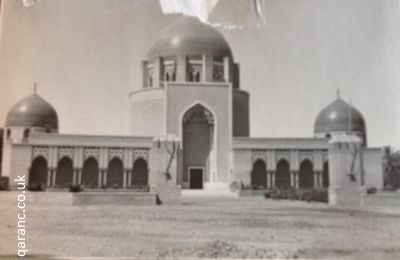
The main entrance into Baghdad is through two massive iron studded gates called the North Gates, and it was through these gates that the British Army entered Baghdad. The flower gardens around the gates are beautiful and well-kept. It is a wonderful city with shops of all kinds, mosques and minarets, a wealthy residential area, modern houses, clubs and hotels, and they seem to wake up at night when the natives have retired to their own huts in the native quarter, where there are zuks for shopping purposes. The new bridge spanning the river was built by the British. It is a wonderful piece of engineering, being very wide, and acting as a real landmark.
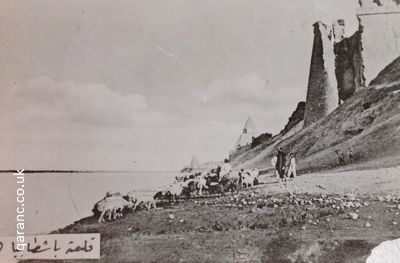
Orders were that I was to proceed to Mosul to open up a large hospital for the British and Indians. This meant travelling through bare and barren country, mostly desert, where battles had been fought in World War I, and where ruined fortresses and hideouts still remained. Mosul is a "white" town, famous for its marble quarries. Everywhere is white - even the donkeys - this being caused by the white powder in the kilns being scattered about. The works were very primitive and the people lived like animals. There was a camel market on the way to the hospital.
The hospital was known as the 28th Combined General and was situated in caves eighty feet below ground, entry to it being by means of a steep runway. The Turkish and Syrian railway ran overhead. The caves were very hot and smelly and electric fans had to be kept going all the time, also the lights. Sanitary arrangements were very bad and, because of the depth and not being strong enough, the pumps would often fail to work away the sewerage. This place was chosen before I arrived on the scene and at times gumboots would be needed to do the rounds, dirty water being ankle deep. The caves had a circular passage, enabling you to walk all round and helping to circulate the air. Large rooms were cut out of the rock, these being converted into wards to accommodate three hundred beds. Tents to hold two hundred and fifty beds had to be erected on top of the caves to deal with those suffering from skin and other infectious diseases. The caves had been used by the Turks for the same purpose in World War I, and also for the storage of rations and ammunition. The reason for opening a hospital in this area was because they expected the enemy to appear in the north of Iraq, through Turkey or over the Ruevandy Pass, so the area had to be strongly guarded. Germans had already landed by parachute at a place called Zukho, near Mosul. Mosul lies only a few miles from the hills of Kurdistan, and from a distance the valley, with its fields of mulberry trees and with the river Tigris passing through, looks like a fairyland.
The staff lived about a mile away from the hospital in rather nice houses taken over by the military authorities, having previously belonged to the families of IPC officials who had been evacuated to the United Kingdom. They travelled to and from the hospital in ambulance transport under armed escort, the natives being very hostile towards us, even children throwing mud to spite us if they had an opportunity, and they would always lie in wait for the transport. We had to pass through the low and dirty part of the town where, on one side, was a camel market with animals both young and old waiting to be sold. On the other side of the street was a large and crude building used for the burning of bodies and here at times the smell was terrible, making us feel quite sick when having to pass by. This was surrounded by a burial ground, women preparing the graves by removing the lime soil with their bare hands. The bodies lay only a few feet down, hence the smell in the terrific heat. Some of the graves had stones, and to these stones the natives would tether their donkeys and camel. It was also a playground for children, and a nearby wool factory would also use the stones for drying the dyed wools of sheep and goats.
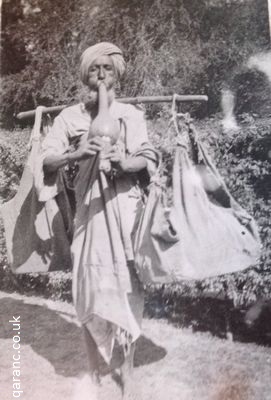
In October 1943 I noticed water trickling down the walls in the caves and ongoing above ground to investigate I found some large cracks appearing. I did not feel very happy about this, I pointed these out to the OC, an Indian colonel. As a race they are usually slow to notice anything abnormal, but this was reported to the Royal Engineers who immediately condemned the caves. This meant that alternative accommodation had to be found, which resulted in the hospital being moved to Kirkuk, about a hundred miles away. The oil refinery officials gave us some ground to pitch the tents, and as most of their families had been sent to the UK all the lovely modern bungalows built around the refineries were vacant so these were handed over to us for the nursing sisters. This certainly was a real luxury, with baths and plenty of hot water. I thought I was in clover for once, but it was not to last!
It was a long, lonely and dangerous journey to get to Kirkuk, through miles of desert called Ut-of-the-Chalders, where big battles had been fought in World War I. The patients were moved in a convoy of ambulances, with armed guards in trucks and lorries riding in between each ambulance. The heat was terrible, making the journey a greater ordeal. There were oil wells situated about a quarter of a mile apart along the road. They had treated the road surface with crude oil so as to keep down the flies. After leaving Mosul we crossed the river Euphrates by means of a large chain bridge, and drove on through the towns of Hilloh, Babylon, Kerbela, and Erbil with its main street shops displaying gay coloured silks and other beautiful materials, all the shops being painted blue which, according to the superstitious natives, keeps away sickness and evil. A very high fort of red stone takes up one side of the street, but we could not stop to see what it was used for now. Here the people dress very attractively, the women being really pretty. They are proud and did not appear in any way poor. Some of the men come from the nomadic Kurdish tribes and Durani Afghans of Giriskh, these claiming decent from the tribes of Israel which Nebuchadnezzar carried into captivity; it is a mixed population. Transport is chiefly by means of camels and beautiful and gaily decorated grey Arab horses. Kabul was another village we passed through, being nomad Afghan, all the people wearing their own pattern dress, and peculiar headgear of yards of silk material folded into a basket shape.
The roads from Erbil to Kirkuk are well kept, this being done by coolies under the supervision of the IPC staff. In one of the crude oil wells on the roadside we passed a monster bullock standing up to its neck in oil: I think it must have walked into it when looking for water. Along this road they were busy sinking oil wells, the noise of drilling into hard rock being deafening. The chimneys of the refinery were smoking in the distance. I visited the refinery with a party and was shown around various rooms where wonderful pumps and machinery were at work. In one place the oil was coming up from the ground, then the different stages it passed through. It was really very interesting and wonderful to watch, then to see it being graded. There was no shortage of oil or petrol here and it was very cheap to buy. All working there had white suits on, the rooms had white tiles from floor to ceiling, and it was absolutely spotless. The natives would collect the crude oil from the roadside wells for their cooking stoves. These stoves were slabs of stone with a small groove down the centre. Two old petrol tins, one with oil and the other with water, would drip their contents along the groove into another tin where it would form an oven fire. This was a really good cooking oven, which we also used, and it never went out.
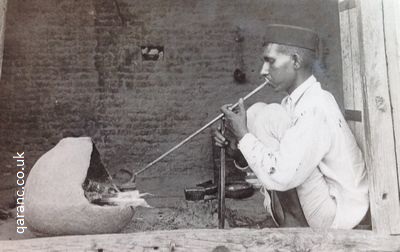
I stayed here long enough to get the hospital organised and running smoothly, and prepared to give the troops in hospital a good Christmas. I had been given six lovely big turkeys for the dinner, and these, while awaiting slaughter, were put in a specially made pen and well-guarded, as the natives in this area were terrible thieves and could easily get away over the plain. I got our Indian cook to make plum puddings and, out of the Indian Red Cross hampers, made up a parcel for each man. Then this luxurious life was too good to be true, for on December 18th orders came through for me to proceed to the desert of Shaiba, a place which I had hoped never to see again. Our colonel and officers pleaded with HQ to let me remain with them, but it was no use and I had to pack up. My little Judy must have thought it a funny life, just getting used to one place then moving off again. Another journey of thirty-six hours! They gave me a wonderful send-off from Kirkuk station, the colonel and some of the Indian officers having tears in their eyes as the train moved off. It made me feel very sad. They had been a grand crowd to work with.
Lt Col Hughes journal continues on the 26th Indian General Hospital page.
Follow us on Facebook, Instagram and Twitter.
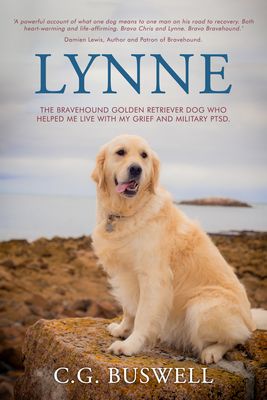
My PTSD assistance dog, Lynne, and I have written a book about how she helps me with my military Post Traumatic Stress Disorder, anxiety, and depression. I talk about my time in the QAs and the coping strategies I now use to be in my best health.
Along the way, I have had help from various military charities, such as Help for Heroes and The Not Forgotten Association and royalties from this book will go to them and other charities like Bravehound, who paired me with my four-legged best friend.
I talk openly about the death of my son by suicide and the help I got from psychotherapy and counselling and grief charities like The Compassionate Friends.
The author, Damien Lewis, said of Lynne:
"A powerful account of what one dog means to one man on his road to recovery. Both heart-warming and life-affirming. Bravo Chris and Lynne. Bravo Bravehound."
Download.
Buy the Paperback.
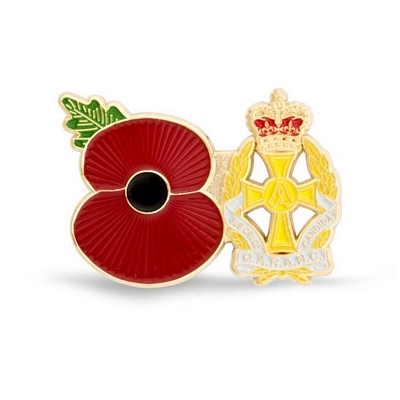
This beautiful QARANC Poppy Pin Badge is available from the Royal British Legion Poppy Shop.
For those searching military records, for information on a former nurse of the QAIMNS, QARANC, Royal Red Cross, VAD and other nursing organisations or other military Corps and Regiments, please try Genes Reunited where you can search for ancestors from military records, census, birth, marriages and death certificates as well as over 673 million family trees. At GenesReunited it is free to build your family tree online and is one of the quickest and easiest ways to discover your family history and accessing army service records.
More Information.
Another genealogy website which gives you access to military records and allows you to build a family tree is Find My Past which has a free trial.
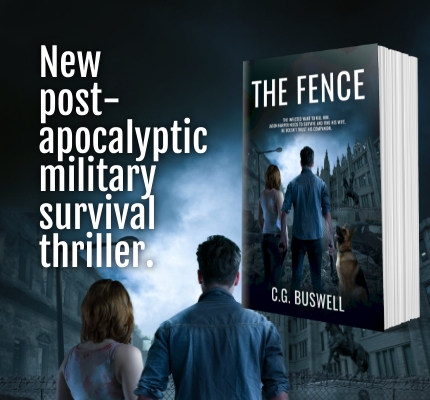
Former Royal Air Force Regiment Gunner Jason Harper witnesses a foreign jet fly over his Aberdeenshire home. It is spilling a strange yellow smoke. Minutes later, his wife, Pippa, telephones him, shouting that she needs him. They then get cut off. He sets straight out, unprepared for the nightmare that unfolds during his journey. Everyone seems to want to kill him.
Along the way, he pairs up with fellow survivor Imogen. But she enjoys killing the living dead far too much. Will she kill Jason in her blood thirst? Or will she hinder his journey through this zombie filled dystopian landscape to find his pregnant wife?
The Fence is the first in this series of post-apocalyptic military survival thrillers from the torturous mind of former British army nurse, now horror and science fiction novel writer, C.G. Buswell.
Download Now.
Buy the Paperback.
If you would like to contribute to this page, suggest changes or inclusions to this website or would like to send me a photograph then please e-mail me.
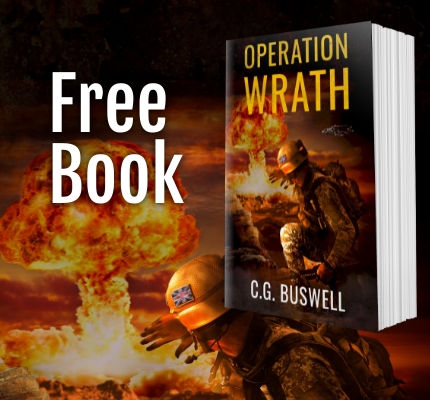
Free Book.
The death of the Brotherhood will be avenged.
RAF gunner Jason Harper and a team of Special Air Service operators are enraged after the death of their brothers by a terrorist drone strike. They fly into south-eastern Yemen on a Black-op mission to gather intelligence and avenge the death of their comrades.
Can they infiltrate the Al-Queda insurgents' camp, stay undetected, and call down their own drone missile strike and get home safely?
Will they all survive to fight another day?
Operation Wrath is a free, fast-paced adventure prequel to the non-stop action The Fence series by military veteran author C.G. Buswell.
Download for free on any device and read today.
This website is not affiliated or endorsed by The Queen Alexandra's Royal Army Nursing Corps (QARANC) or the Ministry of Defence.
» Contact
» Advertise
» QARANC Poppy Pin
» Poppy Lottery
» The Grey Lady Ghost of the Cambridge Military Hospital Novel - a Book by CG Buswell
» The Drummer Boy Novel
» Regimental Cap Badges Paintings
Read our posts on:
Offers
» Army Discounts
» Claim Uniform Washing Tax Rebate For Laundry
» Help For Heroes Discount Code
» Commemorative Cover BFPS 70th anniversary QARANC Association

Present Day
» Become An Army Nurse
» Junior Ranks
» Officer Ranks
» Abbreviations
» Nicknames
» Service Numbers
Ministry of Defence Hospital Units
» MDHU Derriford
» MDHU Frimley Park
» MDHU Northallerton
» MDHU Peterborough
» MDHU Portsmouth
» RCDM Birmingham
» Army Reserve QARANC
Photos
» Florence Nightingale Plaque
» Photographs
Uniform
» Why QA's Wear Grey
» Beret
» Army Medical Services Tartan
» First Time Nurses Wore Trousers AV Anti Vermin Battledress
» TRF Tactical Recognition Flash Badge
» Greatcoat TFNS
» Lapel Pin Badge
» Army School of Psychiatric Nursing Silver Badge
» Cap Badge
» Corps Belt
» ID Bracelet
» Silver War Badge WWI
» Officer's Cloak
» QAIMNSR Tippet
» QAIMNS and Reserve Uniform World War One
» Officer Medal
» Hospital Blues Uniform WW1
Events
» Armed Forces Day
» The Nurses General Dame Maud McCarthy Exhibition Oxford House London
» Edinburgh Fringe Stage Play I'll Tell You This for Nothing - My Mother the War Hero
» Match For Heroes
» Recreated WWI Ward
» Reunions
» Corps Day
» Freedom of Rushmoor
» Re-enactment Groups
» Military Events
» Remembrance
» AMS Carol Service
» QARANC Association Pilgrimage to Singapore and Malaysia 2009
» Doctors and Nurses at War
» War and Medicine Exhibition
» International Conference on Disaster and Military Medicine DiMiMED
» QA Uniform Exhibition Nothe Fort Weymouth
Famous QA's
» Dame Margot Turner
» Dame Maud McCarthy
» Lt Col Maureen Gara
» Military Medal Awards To QAs
» Moment of Truth TV Documentary
» Sean Beech
» Staff Nurse Ella Kate Cooke
Nursing
Nursing Jobs Vacancies UK
International Nurses Day
International Midwife Day
Info
» Search
» Site Map
» Contact
» Other Websites
» Walter Mitty Military Imposters
» The Abandoned Soldier
We are seeking help with some answers to questions sent by readers. These can be found on the Army Nursing page.
» Find QA's
» Jokes
» Merchandise
» Mugs
» Personalised Poster
» Poppy Badges
» Stamp
» Teddy Bears
» Pin Badges
» Wall Plaques
» Fridge Magnet

